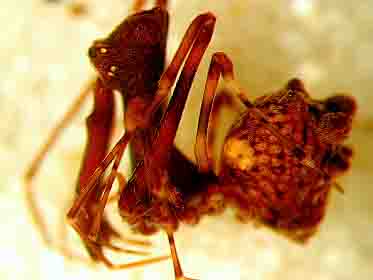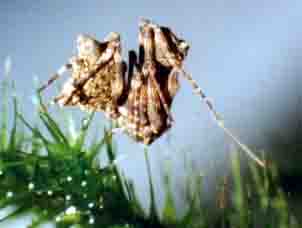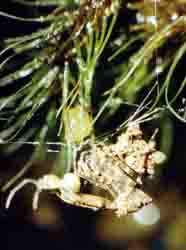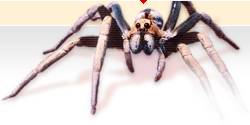
Pelican Spiders
Archaeidae Koch and Berendt, 1854
(compiled by Michael G. Rix, with photographs by the author)
Identification
 opens in new window
opens in new window
from south-eastern Queensland
Pelican spiders are small (but not tiny) in size (less than 5 mm in body length), and usually brown or red-brown in colour. They are instantly recognisable by the remarkable shape of the cephalothorax and pars cephalica (head-region), the latter of which is elevated on top of a long 'neck'. The chelicerae are concomitantly elongate and spear-like, armed with a distal row of peg teeth which are used to impale their spider prey. The combination of a long neck and long chelicerae makes these spiders distinctly 'pelican-like' in appearance, hence the common name. Archaeidae also possess eight eyes and long legs with a particularly long patella on leg I. The female genitalia are haplogyne with multiple spermathecae, and the male pedipalp is bulbous with a sinuous distal embolus and associated sclerites. The males of Australian pelican spiders also possess a dark dorsal scute on the abdomen. Males and females of most species possess two or three pairs of dorsal lumps or tubercles on the abdomen.
Biology
 opens in new window
opens in new window
from south-eastern Queensland,
sitting on wet moss.
In eastern Australia, pelican spiders are usually found within temperate, subtropical or montane tropical rainforest, where they live within dense, low-growing vegetation, leaf litter, or on moss growing on logs or tree trunks. In south-western Western Australia, pelican spiders are rare, and are usually found in dense undergrowth, including coastal and montane heathland. The spiders build a line of silk at night, from which they hang upside-down to wait for their spider prey. The extremely long chelicerae, which are armed with peg teeth opposite the fangs, are used to spear and impale wandering spiders.
 opens in new window
opens in new window
with impaled spider prey at night.
Pelican spiders are cryptic and extremely well-camouflaged in nature, looking like inconspicuous seeds or pieces of organic debris lodged in vegetation - a disguise heightened by their ability to 'sway' from side-to-side in the breeze and when disturbed (similar to Mantodea and Phasmatodea among the insects).
Pelican Spiders in Australasia
Five archaeid species have been described from Australasia, although many new species are known from New South Wales and Queensland, and a single new species is known from south-western Western Australia (M. Rix and M. Harvey, work in progress). Pelican spiders are also diverse in Madagascar and south-eastern South Africa.
Australia
Five archaeid species have been described from Australia, all currently placed in the genus Austrarchaea Forster & Platnick, 1984. :
- Austrarchaea daviesae Forster and Platnick, 1984 (northeastern Queensland)
- Austrarchaea hickmani (Butler, 1929) (Victoria)
- Austrarchaea nodosa (Forster, 1956) (southeastern Queensland)
- Austrarchaea mainae Platnick, 1991 (southwestern Western Australia)
- Austrarchaea robinsi Harvey, 2002 (southwestern Western Australia)
New Zealand
Archaeid spiders are not known from New Zealand.
South East Asia
Archaeid spiders are not known from South East Asia.
References
Butler, L.S.G. 1929. Studies in Victorian spiders, no. 1. Proceedings of the Royal Society of Victoria 42, 41-52.
Forster, R.R. 1956. A new spider of the genus Archaea from Australia. Memoirs of the Queensland Museum 13, 151-154.
Forster, R.R. and Platnick, N.I. 1984. A review of the archaeid spiders and their relatives, with notes on the limits of the superfamily Palpimanoidea. Bulletin of the American Museum of Natural History 178, 1-106.
Harvey, M.S. 2002. A new species of Austrarchaea (Araneae: Archaeidae) from Western Australia. Records of the Western Australian Museum 21, 35-37.
Koch, C.L. and Berendt, G.C. 1854. Die im Bernstein befindlichen Crustaceen, Myriapoden, Arachniden und Apteren der Vorwelt. In Berendt, G.C. (ed.) Die im Bernstein befindlichen Organischen Reste der Vorwelt. Berlin, vol. 1, pt. 2, pp. 1-124, pls. 1-18.
Platnick, N. I. 1991. On Western Australian Austrarchaea (Araneae, Archaeidae). Bulletin of the British Arachnological Society 8, 259-261.

